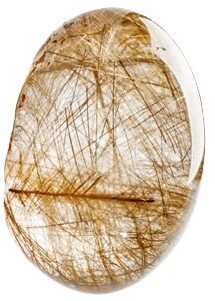
Rutile quartz, is a stunning and versatile mineral, has captured the interest of gemologists, collectors, and scientists alike. Renowned for its unique golden or reddish needle-like inclusions, it is not only prized for its aesthetics but also for its industrial and metaphysical applications. This comprehensive article explores its origins, composition, geological occurrences, historical and modern uses, folklore, mystical properties, and more.
Origins of Its Name and Alternate Names
The name “Rutile” derives from the Latin word rutilus, meaning “reddish,” reflecting its natural reddish-brown hue. German scientist Abraham Gottlob Werner first applied the name to this mineral in 1800.
Alternate names for Rutile are often descriptive, such as “Venus Hair Stone,” used when referring to quartz with rutile inclusions that resemble golden threads. In industrial contexts, Rutile is sometimes called “Titanium Ore” due to its titanium dioxide composition.
Composition and Physical Characteristics
Rutile is a titanium dioxide mineral (TiO₂) with a tetragonal crystal system. Its unique physical and optical properties make it a sought-after material in a variety of fields.
Physical Characteristics and Varieties:
- Appearance: Typically reddish-brown, golden, or black, often found as needle-like inclusions within other gemstones such as quartz and corundum.
- Lustre: Exhibits an adamantine to submetallic sheen.
- Hardness: Measures 6 to 6.5 on the Mohs scale, making it moderately hard.
- Crystal Structure: Forms prismatic or acicular crystals with high refractive indices and dispersion.
Varieties include:
- Sagenite: Rutile in a network of intersecting needles within quartz.
- Rutilated Quartz: Transparent quartz featuring Rutile inclusions, highly valued in jewellery.
- Anatase and Brookite: Polymorphs of Rutile with identical chemical compositions but different crystal structures.
Geographical Locations
Rutile is found worldwide, often in igneous and metamorphic rocks or as detrital grains in sediments. Major locations include:
- Brazil: Known for high-quality rutilated quartz specimens.
- India: A significant producer of industrial-grade Rutile.
- Australia: Home to large deposits mined for titanium extraction.
- Norway: Features prominent reserves of high-purity Rutile.
- United States: Found in Virginia, North Carolina, and Arkansas.
Historical and Current Usage
Rutile has been utilised for both decorative and functional purposes throughout history. Ancient civilisations admired its golden inclusions in quartz, believing them to be threads from the gods.
In modern times, Rutile’s applications have expanded significantly:
- Jewellery: Used as a gemstone and in quartz inclusions to enhance visual appeal.
- Pigments: A primary source of white pigment in paints, ceramics, and plastics.
- Industry: An essential mineral for producing titanium metal, used in aerospace, medical implants, and more.
Interesting Facts
- Rutile has one of the highest refractive indices of any known mineral, making it highly brilliant and reflective.
- It is a diagnostic mineral for geologists, helping to determine the history of rock formations.
- Inclusions of Rutile in quartz and sapphire are often referred to as “angel hair” due to their ethereal appearance.
Folklore, Superstition, Legends, and Tales
The golden threads of Rutile inclusions are often referred to as “Hair of the Angels,” a term suggesting a direct connection to heavenly beings. Ancient cultures believed these shimmering strands within the quartz were gifts from the angels, imbued with protection, guidance, and spiritual energy. Carrying or wearing rutilated quartz was thought to strengthen one’s bond with the celestial realm, inviting blessings and divine intervention.
Linked to the Roman god of love Cupid, the Rutile needles represent “Cupid’s Arrows,” shot to awaken love and desire. Some traditions held that wearing or meditating with rutilated quartz could enhance relationships, attract true love, or heal emotional wounds left by unrequited love.
Rutilated quartz is also connected to various goddesses across cultures, each adding unique layers to its mystical allure. In Greco-Roman mythology, the stone was often dedicated to Venus (Aphrodite), the goddess of love and beauty, symbolising passion and romantic harmony.
Similarly, in Norse mythology, it was associated with Freyja, the goddess of love, fertility, and magic, revered for her ability to connect the earthly and the divine. In Hindu traditions, it is linked to Lakshmi, the goddess of wealth and abundance, believed to attract prosperity and blessings.
In some traditions, Rutile was regarded as a “Stone of Truth,” believed to illuminate hidden truths and encourage honesty. It was also considered a talisman for protection and strength, warding off negativity and fostering resilience.
Legends from Europe describe Rutile as a mystical tool for divination. Scrying with rutilated quartz was thought to reveal visions of the future, while its shimmering inclusions were seen as channels for spiritual insight.
Mystical Healing Properties
Rutile is revered for its metaphysical properties, particularly when included in quartz:
- Emotional Healing: Enhances focus and mental clarity, helping to dispel confusion and anxiety.
- Physical Healing: Believed to stimulate cell regeneration and improve energy flow.
- Spiritual Healing: Encourages spiritual growth and alignment with higher realms.
Astrological Links and the Chakra System
Rutile resonates with multiple chakras, depending on its usage and pairing:
- Solar Plexus Chakra: Stimulates personal power and confidence.
- Crown Chakra: Promotes spiritual awareness and enlightenment.
Astrologically, Rutile is often linked to Leo and Gemini, enhancing creativity, communication, and motivation.
Use as a Birthstone and Wedding Anniversary Gift
While not an official birthstone, Rutile is sometimes used as an alternative for those seeking a unique and symbolic gemstone for personal or gifting purposes.
For wedding anniversaries, rutilated quartz serves as a meaningful gift, symbolising transparency and the intertwined threads of a strong relationship.
Rutile, with its dazzling inclusions, scientific importance, and spiritual significance, continues to captivate those who encounter it. Whether admired for its beauty or harnessed for its properties, this remarkable mineral is truly a gift from the Earth.

Rutile Quartz
Rutile Quartz features golden needle-like inclusions that amplify energy, boost intuition, and inspire clarity. A radiant stone for spiritual growth.
